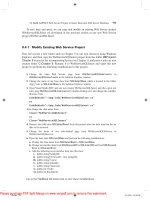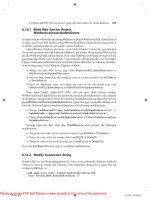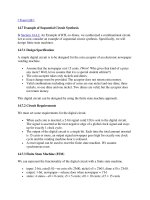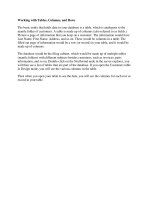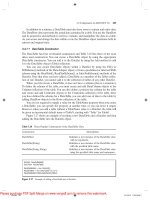Mastering OpenCV with Practical Computer Vision Projects pptx
Bạn đang xem bản rút gọn của tài liệu. Xem và tải ngay bản đầy đủ của tài liệu tại đây (6.92 MB, 340 trang )
www.it-ebooks.info
Mastering OpenCV with
Practical Computer Vision
Projects
Step-by-step tutorials to solve common real-world
computer vision problems for desktop or mobile, from
augmented reality and number plate recognition to face
recognition and 3D head tracking
Daniel Lélis Baggio
Shervin Emami
David Millán Escrivá
Khvedchenia Ievgen
Naureen Mahmood
Jason Saragih
Roy Shilkrot
BIRMINGHAM - MUMBAI
www.it-ebooks.info
Mastering OpenCV with Practical Computer
Vision Projects
Copyright © 2012 Packt Publishing
All rights reserved. No part of this book may be reproduced, stored in a retrieval
system, or transmitted in any form or by any means, without the prior written
permission of the publisher, except in the case of brief quotations embedded in
critical articles or reviews.
Every effort has been made in the preparation of this book to ensure the accuracy
of the information presented. However, the information contained in this book is
sold without warranty, either express or implied. Neither the authors, nor Packt
Publishing, and its dealers and distributors will be held liable for any damages
caused or alleged to be caused directly or indirectly by this book.
Packt Publishing has endeavored to provide trademark information about all of the
companies and products mentioned in this book by the appropriate use of capitals.
However, Packt Publishing cannot guarantee the accuracy of this information.
First published: December 2012
Production Reference: 2231112
Published by Packt Publishing Ltd.
Livery Place
35 Livery Street
Birmingham B3 2PB, UK.
ISBN 978-1-84951-782-9
www.packtpub.com
Cover Image by Neha Rajappan ()
www.it-ebooks.info
Credits
Authors
Daniel Lélis Baggio
Shervin Emami
David Millán Escrivá
Khvedchenia Ievgen
Naureen Mahmood
Jason Saragih
Roy Shilkrot
Reviewers
Kirill Kornyakov
Luis Díaz Más
Sebastian Montabone
Acquisition Editor
Usha Iyer
Lead Technical Editor
Ankita Shashi
Technical Editors
Sharvari Baet
Prashant Salvi
Copy Editors
Brandt D'Mello
Aditya Nair
Alda Paiva
Project Coordinator
Priya Sharma
Proofreaders
Chris Brown
Martin Diver
Indexer
Hemangini Bari
Tejal Soni
Rekha Nair
Graphics
Valentina D'silva
Aditi Gajjar
Production Coordinator
Arvindkumar Gupta
Cover Work
Arvindkumar Gupta
www.it-ebooks.info
About the Authors
Daniel Lélis Baggio started his work in computer vision through medical image
processing at InCor (Instituto do Coração – Heart Institute) in São Paulo, where
he worked with intra-vascular ultrasound image segmentation. Since then, he has
focused on GPGPU and ported the segmentation algorithm to work with NVIDIA's
CUDA. He has also dived into six degrees of freedom head tracking with a natural
user interface group through a project called ehci ( />ehci/
). He now works for the Brazilian Air Force.
I'd like to thank God for the opportunity of working with computer
vision. I try to understand the wonderful algorithms He has created
for us to see. I also thank my family, and especially my wife, for all
their support throughout the development of the book. I'd like to
dedicate this book to my son Stefano.
Shervin Emami (born in Iran) taught himself electronics and hobby robotics
during his early teens in Australia. While building his rst robot at the age of 15,
he learned how RAM and CPUs work. He was so amazed by the concept that
he soon designed and built a whole Z80 motherboard to control his robot, and
wrote all the software purely in binary machine code using two push buttons
for 0s and 1s. After learning that computers can be programmed in much easier
ways such as assembly language and even high-level compilers, Shervin became
hooked to computer programming and has been programming desktops, robots,
and smartphones nearly every day since then. During his late teens he created
Draw3D (o/), a 3D modeler with 30,000 lines
of optimized C and assembly code that rendered 3D graphics faster than all the
commercial alternatives of the time; but he lost interest in graphics programming
when 3D hardware acceleration became available.
www.it-ebooks.info
In University, Shervin took a subject on computer vision and became highly
interested in it; so for his rst thesis in 2003 he created a real-time face detection
program based on Eigenfaces, using OpenCV (beta 3) for camera input. For his
master's thesis in 2005 he created a visual navigation system for several mobile
robots using OpenCV (v0.96). From 2008, he worked as a freelance Computer Vision
Developer in Abu Dhabi and Philippines, using OpenCV for a large number of
short-term commercial projects that included:
• Detecting faces using Haar or Eigenfaces
• Recognizing faces using Neural Networks, EHMM, or Eigenfaces
• Detecting the 3D position and orientation of a face from a single photo using
AAM and POSIT
• Rotating a face in 3D using only a single photo
• Face preprocessing and articial lighting using any 3D direction from a
single photo
• Gender recognition
• Facial expression recognition
• Skin detection
• Iris detection
• Pupil detection
• Eye-gaze tracking
• Visual-saliency tracking
• Histogram matching
• Body-size detection
• Shirt and bikini detection
• Money recognition
• Video stabilization
• Face recognition on iPhone
• Food recognition on iPhone
• Marker-based augmented reality on iPhone (the second-fastest iPhone
augmented reality app at the time).
www.it-ebooks.info
OpenCV was putting food on the table for Shervin's family, so he began giving
back to OpenCV through regular advice on the forums and by posting free OpenCV
tutorials on his website (o/openCV.html). In 2011,
he contacted the owners of other free OpenCV websites to write this book. He also
began working on computer vision optimization for mobile devices at NVIDIA,
working closely with the ofcial OpenCV developers to produce an optimized
version of OpenCV for Android. In 2012, he also joined the Khronos OpenVL
committee for standardizing the hardware acceleration of computer vision for mobile
devices, on which OpenCV will be based in the future.
I thank my wife Gay and my baby Luna for enduring the stress while
I juggled my time between this book, working fulltime, and raising a
family. I also thank the developers of OpenCV, who worked hard for
many years to provide a high-quality product for free.
David Millán Escrivá was eight years old when he wrote his rst program on
an 8086 PC with Basic language, which enabled the 2D plotting of basic equations.
In 2005, he nished his studies in IT through the Universitat Politécnica de Valencia
with honors in human-computer interaction supported by computer vision with
OpenCV (v0.96). He had a nal project based on this subject and published it on
HCI Spanish congress. He participated in Blender, an open source, 3D-software
project, and worked in his rst commercial movie Plumiferos - Aventuras voladoras as
a Computer Graphics Software Developer.
David now has more than 10 years of experience in IT, with experience in
computer vision, computer graphics, and pattern recognition, working on
different projects and startups, applying his knowledge of computer vision,
optical character recognition, and augmented reality. He is the author of the
"DamilesBlog" (
), where he publishes research
articles and tutorials about OpenCV, computer vision in general, and Optical
Character Recognition algorithms.
www.it-ebooks.info
David has reviewed the book gnuPlot Cookbook by Lee Phillips and published
by Packt Publishing.
Thanks Izaskun and my daughter Eider for their patience
and support. Os quiero pequeñas.
I also thank Shervin for giving me this opportunity, the OpenCV
team for their work, the support of Artres, and the useful help
provided by Augmate.
Khvedchenia Ievgen is a computer vision expert from Ukraine. He started his
career with research and development of a camera-based driver assistance system
for Harman International. He then began working as a Computer Vision Consultant
for ESG. Nowadays, he is a self-employed developer focusing on the development of
augmented reality applications. Ievgen is the author of the Computer Vision Talks blog
(), where he publishes research articles and
tutorials pertaining to computer vision and augmented reality.
I would like to say thanks to my father who inspired me to
learn programming when I was 14. His help can't be overstated.
And thanks to my mom, who always supported me in all my
undertakings. You always gave me a freedom to choose my own
way in this life. Thanks, parents!
Thanks to Kate, a woman who totally changed my life and made it
extremely full. I'm happy we're together. Love you.
www.it-ebooks.info
Naureen Mahmood is a recent graduate from the Visualization department
at Texas A&M University. She has experience working in various programming
environments, animation software, and microcontroller electronics. Her work
involves creating interactive applications using sensor-based electronics and
software engineering. She has also worked on creating physics-based simulations
and their use in special effects for animation.
I wanted to especially mention the efforts of another student from
Texas A&M, whose name you will undoubtedly come across in the
code included for this book. Fluid Wall was developed as part of
a student project by Austin Hines and myself. Major credit for the
project goes to Austin, as he was the creative mind behind it. He
was also responsible for the arduous job of implementing the uid
simulation code into our application. However, he wasn't able to
participate in writing this book due to a number of work- and
study-related preoccupations.
Jason Saragih received his B.Eng degree in mechatronics (with honors) and Ph.D.
in computer science from the Australian National University, Canberra, Australia,
in 2004 and 2008, respectively. From 2008 to 2010 he was a Postdoctoral fellow at the
Robotics Institute of Carnegie Mellon University, Pittsburgh, PA. From 2010 to 2012
he worked at the Commonwealth Scientic and Industrial Research Organization
(CSIRO) as a Research Scientist. He is currently a Senior Research Scientist at Visual
Features, an Australian tech startup company.
Dr. Saragih has made a number of contributions to the eld of computer vision,
specically on the topic of deformable model registration and modeling. He is the
author of two non-prot open source libraries that are widely used in the scientic
community; DeMoLib and FaceTracker, both of which make use of generic computer
vision libraries including OpenCV.
www.it-ebooks.info
Roy Shilkrot is a researcher and professional in the area of computer vision and
computer graphics. He obtained a B.Sc. in Computer Science from Tel-Aviv-Yaffo
Academic College, and an M.Sc. from Tel-Aviv University. He is currently a PhD
candidate in Media Laboratory of the Massachusetts Institute of Technology (MIT)
in Cambridge.
Roy has over seven years of experience as a Software Engineer in start-up companies
and enterprises. Before joining the MIT Media Lab as a Research Assistant he worked
as a Technology Strategist in the Innovation Laboratory of Comverse, a telecom
solutions provider. He also dabbled in consultancy, and worked as an intern for
Microsoft research at Redmond.
Thanks go to my wife for her limitless support and patience, my past
and present advisors in both academia and industry for their wisdom,
and my friends and colleagues for their challenging thoughts.
www.it-ebooks.info
About the Reviewers
Kirill Kornyakov is a Project Manager at Itseez, where he leads the development
of OpenCV library for Android mobile devices. He manages activities for the
mobile operating system's support and computer vision applications development,
including performance optimization for NVIDIA's Tegra platform. Earlier he worked
at Itseez on real-time computer vision systems for open source and commercial
products, chief among them being stereo vision on GPU and face detection in
complex environments. Kirill has a B.Sc. and an M.Sc. from Nizhniy Novgorod
State University, Russia.
I would like to thank my family for their support, my colleagues
from Itseez, and Nizhniy Novgorod State University for productive
discussions.
Luis Díaz Más considers himself a computer vision researcher and is passionate
about open source and open-hardware communities. He has been working with
image processing and computer vision algorithms since 2008 and is currently
nishing his PhD on 3D reconstructions and action recognition. Currently he is
working in CATEC ( a research center for advanced
aerospace technologies, where he mainly deals with the sensorial systems of UAVs.
He has participated in several national and international projects where he has
proven his skills in C/C++ programming, application development for embedded
systems with Qt libraries, and his experience with GNU/Linux distribution
conguration for embedded systems. Lately he is focusing his interest in ARM
and CUDA development.
www.it-ebooks.info
Sebastian Montabone is a Computer Engineer with a Master of Science degree in
computer vision. He is the author of scientic articles pertaining to image processing
and has also authored a book, Beginning Digital Image Processing: Using Free Tools
for Photographers.
Embedded systems have also been of interest to him, especially mobile phones.
He created and taught a course about the development of applications for mobile
phones, and has been recognized as a Nokia developer champion.
Currently he is a Software Consultant and Entrepreneur. You can visit his blog at
www.samontab.com, where he shares his current projects with the world.
www.it-ebooks.info
www.PacktPub.com
Support les, eBooks, discount offers and more
You might want to visit www.PacktPub.com for support les and downloads related
to your book.
Did you know that Packt offers eBook versions of every book published, with PDF
and ePub les available? You can upgrade to the eBook version at
www.PacktPub.
com
and as a print book customer, you are entitled to a discount on the eBook copy.
Get in touch with us at for more details.
At
www.PacktPub.com, you can also read a collection of free technical articles, sign
up for a range of free newsletters and receive exclusive discounts and offers on Packt
books and eBooks.
Do you need instant solutions to your IT questions? PacktLib is Packt's online
digital book library. Here, you can access, read and search across Packt's entire
library of books.
Why Subscribe?
• Fully searchable across every book published by Packt
• Copy and paste, print and bookmark content
• On demand and accessible via web browser
Free Access for Packt account holders
If you have an account with Packt at www.PacktPub.com, you can use this to access
PacktLib today and view nine entirely free books. Simply use your login credentials
for immediate access.
www.it-ebooks.info
Table of Contents
Preface 1
Chapter 1: Cartoonier and Skin Changer for Android 7
Accessing the webcam 9
Main camera processing loop for a desktop app 10
Generating a black-and-white sketch 11
Generating a color painting and a cartoon 12
Generating an "evil" mode using edge lters 14
Generating an "alien" mode using skin detection 16
Skin-detection algorithm 16
Showing the user where to put their face 17
Implementation of the skin-color changer 19
Porting from desktop to Android 24
Setting up an Android project that uses OpenCV 24
Color formats used for image processing on Android 25
Input color format from the camera 25
Output color format for display 26
Adding the cartoonier code to the Android NDK app 28
Reviewing the Android app 30
Cartoonifying the image when the user taps the screen 31
Saving the image to a le and to the Android picture gallery 33
Showing an Android notication message about a saved image 36
Changing cartoon modes through the Android menu bar 37
Reducing the random pepper noise from the sketch image 40
Showing the FPS of the app 43
Using a different camera resolution 43
Customizing the app 44
Summary 45
www.it-ebooks.info
Table of Contents
[ ii ]
Chapter 2: Marker-based Augmented Reality on iPhone or iPad 47
Creating an iOS project that uses OpenCV 48
Adding OpenCV framework 49
Including OpenCV headers 51
Application architecture 52
Marker detection 62
Marker identication 64
Grayscale conversion 64
Image binarization 65
Contours detection 66
Candidates search 67
Marker code recognition 72
Reading marker code 72
Marker location renement 74
Placing a marker in 3D 76
Camera calibration 76
Marker pose estimation 78
Rendering the 3D virtual object 82
Creating the OpenGL rendering layer 82
Rendering an AR scene 85
Summary 92
References 92
Chapter 3: Marker-less Augmented Reality 93
Marker-based versus marker-less AR 94
Using feature descriptors to nd an arbitrary image on video 95
Feature extraction 95
Denition of a pattern object 98
Matching of feature points 98
PatternDetector.cpp 99
Outlier removal 100
Cross-match lter 101
Ratio test 101
Homography estimation 102
Homography renement 104
Putting it all together 107
Pattern pose estimation 108
PatternDetector.cpp 108
Obtaining the camera-intrinsic matrix 110
Pattern.cpp 113
Application infrastructure 114
ARPipeline.hpp 115
ARPipeline.cpp 115
Enabling support for 3D visualization in OpenCV 116
www.it-ebooks.info
Table of Contents
[ iii ]
Creating OpenGL windows using OpenCV 118
Video capture using OpenCV 118
Rendering augmented reality 119
ARDrawingContext.hpp 119
ARDrawingContext.cpp 120
Demonstration 122
main.cpp 123
Summary 126
References 127
Chapter 4: Exploring Structure from Motion Using OpenCV 129
Structure from Motion concepts 130
Estimating the camera motion from a pair of images 132
Point matching using rich feature descriptors 132
Point matching using optical ow 134
Finding camera matrices 139
Reconstructing the scene 143
Reconstruction from many views 147
Renement of the reconstruction 151
Visualizing 3D point clouds with PCL 155
Using the example code 158
Summary 159
References 160
Chapter 5: Number Plate Recognition Using SVM and
Neural Networks 161
Introduction to ANPR 161
ANPR algorithm 163
Plate detection 166
Segmentation 167
Classication 173
Plate recognition 176
OCR segmentation 177
Feature extraction 178
OCR classication 181
Evaluation 185
Summary 188
Chapter 6: Non-rigid Face Tracking 189
Overview 191
Utilities 191
Object-oriented design 191
www.it-ebooks.info
Table of Contents
[ iv ]
Data collection: Image and video annotation 193
Training data types 194
Annotation tool 198
Pre-annotated data (The MUCT dataset) 198
Geometrical constraints 199
Procrustes analysis 202
Linear shape models 205
A combined local-global representation 207
Training and visualization 209
Facial feature detectors 212
Correlation-based patch models 214
Learning discriminative patch models 214
Generative versus discriminative patch models 218
Accounting for global geometric transformations 219
Training and visualization 222
Face detection and initialization 224
Face tracking 228
Face tracker implementation 229
Training and visualization 231
Generic versus person-specic models 232
Summary 233
References 233
Chapter 7: 3D Head Pose Estimation Using AAM and POSIT 235
Active Appearance Models overview 236
Active Shape Models 238
Getting the feel of PCA 240
Triangulation 245
Triangle texture warping 247
Model Instantiation – playing with the Active Appearance Model 249
AAM search and tting 250
POSIT 253
Diving into POSIT 253
POSIT and head model 256
Tracking from webcam or video le 257
Summary 259
References 260
Chapter 8: Face Recognition using Eigenfaces or Fisherfaces 261
Introduction to face recognition and face detection 261
Step 1: Face detection 263
Implementing face detection using OpenCV 264
Loading a Haar or LBP detector for object or face detection 265
Accessing the webcam 266
www.it-ebooks.info
Table of Contents
[ v ]
Detecting an object using the Haar or LBP Classier 266
Detecting the face 268
Step 2: Face preprocessing 270
Eye detection 271
Eye search regions 272
Step 3: Collecting faces and learning from them 281
Collecting preprocessed faces for training 283
Training the face recognition system from collected faces 285
Viewing the learned knowledge 287
Average face 289
Eigenvalues, Eigenfaces, and Fisherfaces 290
Step 4: Face recognition 292
Face identication: Recognizing people from their face 292
Face verication: Validating that it is the claimed person 292
Finishing touches: Saving and loading les 295
Finishing touches: Making a nice and interactive GUI 295
Drawing the GUI elements 297
Checking and handling mouse clicks 306
Summary 308
References 309
Index 311
www.it-ebooks.info
www.it-ebooks.info
Preface
Mastering OpenCV with Practical Computer Vision Projects contains nine chapters, where
each chapter is a tutorial for an entire project from start to nish, based on OpenCV's
C++ interface including full source code. The author of each chapter was chosen for
their well-regarded online contributions to the OpenCV community on that topic,
and the book was reviewed by one of the main OpenCV developers. Rather than
explaining the basics of OpenCV functions, this is the rst book that shows how
to apply OpenCV to solve whole problems, including several 3D camera projects
(augmented reality, 3D Structure from Motion, Kinect interaction) and several facial
analysis projects (such as, skin detection, simple face and eye detection, complex facial
feature tracking, 3D head orientation estimation, and face recognition), therefore it
makes a great companion to existing OpenCV books.
What this book covers
Chapter 1, Cartoonier and Skin Changer for Android, contains a complete tutorial and
source code for both a desktop application and an Android app that automatically
generates a cartoon or painting from a real camera image, with several possible types
of cartoons including a skin color changer.
Chapter 2, Marker-based Augmented Reality on iPhone or iPad, contains a complete
tutorial on how to build a marker-based augmented reality (AR) application for
iPad and iPhone devices with an explanation of each step and source code.
Chapter 3, Marker-less Augmented Reality, contains a complete tutorial on how to
develop a marker-less augmented reality desktop application with an explanation
of what marker-less AR is and source code.
Chapter 4, Exploring Structure from Motion Using OpenCV, contains an introduction
to Structure from Motion (SfM) via an implementation of SfM concepts in OpenCV.
The reader will learn how to reconstruct 3D geometry from multiple 2D images and
estimate camera positions.
www.it-ebooks.info
Preface
[ 2 ]
Chapter 5, Number Plate Recognition Using SVM and Neural Networks, contains a
complete tutorial and source code to build an automatic number plate recognition
application using pattern recognition algorithms using a support vector machine
and Articial Neural Networks. The reader will learn how to train and predict
pattern-recognition algorithms to decide if an image is a number plate or not.
It will also help classify a set of features into a character.
Chapter 6, Non-rigid Face Tracking, contains a complete tutorial and source code to
build a dynamic face tracking system that can model and track the many complex
parts of a person's face.
Chapter 7, 3D Head Pose Estimation Using AAM and POSIT, contains all the
background required to understand what Active Appearance Models (AAMs) are
and how to create them with OpenCV using a set of face frames with different facial
expressions. Besides, this chapter explains how to match a given frame through
tting capabilities offered by AAMs. Then, by applying the POSIT algorithm, one
can nd the 3D head pose.
Chapter 8, Face Recognition using Eigenfaces or Fisherfaces, contains a complete tutorial
and source code for a real-time face-recognition application that includes basic face
and eye detection to handle the rotation of faces and varying lighting conditions in
the images.
Chapter 9, Developing Fluid Wall Using the Microsoft Kinect, covers the complete
development of an interactive uid simulation called the Fluid Wall, which uses
the Kinect sensor. The chapter will explain how to use Kinect data with OpenCV's
optical ow methods and integrating it into a uid solver.
You can download this chapter from:
/>files/downloads/7829OS_Chapter9_Developing_Fluid_Wall_Using_the_
Microsoft_Kinect.pdf
.
What you need for this book
You don't need to have special knowledge in computer vision to read this book, but
you should have good C/C++ programming skills and basic experience with OpenCV
before reading this book. Readers without experience in OpenCV may wish to read the
book Learning OpenCV for an introduction to the OpenCV features, or read OpenCV 2
Cookbook for examples on how to use OpenCV with recommended C/C++ patterns,
because Mastering OpenCV with Practical Computer Vision Projects will show you how
to solve real problems, assuming you are already familiar with the basics of OpenCV
and C/C++ development.
www.it-ebooks.info
Preface
[ 3 ]
In addition to C/C++ and OpenCV experience, you will also need a computer, and
IDE of your choice (such as Visual Studio, XCode, Eclipse, or QtCreator, running on
Windows, Mac or Linux). Some chapters have further requirements, in particular:
• To develop the Android app, you will need an Android device, Android
development tools, and basic Android development experience.
• To develop the iOS app, you will need an iPhone, iPad, or iPod Touch
device, iOS development tools (including an Apple computer, XCode
IDE, and an Apple Developer Certicate), and basic iOS and Objective-C
development experience.
• Several desktop projects require a webcam connected to your computer. Any
common USB webcam should sufce, but a webcam of at least 1 megapixel
may be desirable.
• CMake is used in some projects, including OpenCV itself, to build across
operating systems and compilers. A basic understanding of build systems is
required, and knowledge of cross-platform building is recommended.
• An understanding of linear algebra is expected, such as basic vector and
matrix operations and eigen decomposition.
Who this book is for
Mastering OpenCV with Practical Computer Vision Projects is the perfect book for
developers with basic OpenCV knowledge to create practical computer vision
projects, as well as for seasoned OpenCV experts who want to add more computer
vision topics to their skill set. It is aimed at senior computer science university
students, graduates, researchers, and computer vision experts who wish to solve real
problems using the OpenCV C++ interface, through practical step-by-step tutorials.
Conventions
In this book, you will nd a number of styles of text that distinguish between
different kinds of information. Here are some examples of these styles, and an
explanation of their meaning.
Code words in text are shown as follows: "You should put most of the code of this
chapter into the
cartoonifyImage() function."
www.it-ebooks.info
Preface
[ 4 ]
A block of code is set as follows:
int cameraNumber = 0;
if (argc > 1)
cameraNumber = atoi(argv[1]);
// Get access to the camera.
cv::VideoCapture capture;
When we wish to draw your attention to a particular part of a code block, the
relevant lines or items are set in bold:
// Get access to the camera.
cv::VideoCapture capture;
camera.open(cameraNumber);
if (!camera.isOpened()) {
std::cerr << "ERROR: Could not access the camera or video!" <<
New terms and important words are shown in bold. Words that you see on the
screen, in menus or dialog boxes for example, appear in the text like this: "clicking
the Next button moves you to the next screen".
Warnings or important notes appear in a box like this.
Tips and tricks appear like this.
Reader feedback
Feedback from our readers is always welcome. Let us know what you think about
this book—what you liked or may have disliked. Reader feedback is important for us
to develop titles that you really get the most out of.
To send us general feedback, simply send an e-mail to
,
and mention the book title via the subject of your message.
If there is a topic that you have expertise in and you are interested in either writing
or contributing to a book, see our author guide on
www.packtpub.com/authors.
www.it-ebooks.info
Preface
[ 5 ]
Customer support
Now that you are the proud owner of a Packt book, we have a number of things to
help you to get the most from your purchase.
Downloading the example code
You can download the example code les for all Packt books you have purchased
from your account at . If you purchased this book
elsewhere, you can visit and register to
have the les e-mailed directly to you.
Errata
Although we have taken every care to ensure the accuracy of our content, mistakes
do happen. If you nd a mistake in one of our books—maybe a mistake in the text or
the code—we would be grateful if you would report this to us. By doing so, you can
save other readers from frustration and help us improve subsequent versions of this
book. If you nd any errata, please report them by visiting ktpub.
com/support
, selecting your book, clicking on the errata submission form link, and
entering the details of your errata. Once your errata are veried, your submission
will be accepted and the errata will be uploaded on our website, or added to any list
of existing errata, under the Errata section of that title. Any existing errata can be
viewed by selecting your title from />Piracy
Piracy of copyright material on the Internet is an ongoing problem across all media.
At Packt, we take the protection of our copyright and licenses very seriously. If you
come across any illegal copies of our works, in any form, on the Internet, please
provide us with the location address or website name immediately so that we can
pursue a remedy.
Please contact us at
with a link to the suspected
pirated material.
We appreciate your help in protecting our authors, and our ability to bring you
valuable content.
Questions
You can contact us at if you are having a problem with
any aspect of the book, and we will do our best to address it.
www.it-ebooks.info
www.it-ebooks.info
